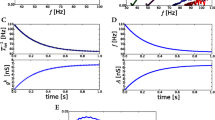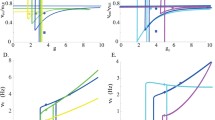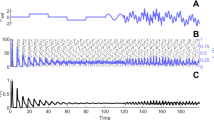Abstract
Changes in firing patterns are an important hallmark of the functional status of neuronal networks. We apply dynamical systems methods to understand transitions between irregular and rhythmic firing in an excitatory-inhibitory neuronal network model. Using the geometric theory of singular perturbations, we systematically reduce the full model to a simpler set of equations, one that can be studied analytically. The analytic tools are used to understand how an excitatory-inhibitory network with a fixed architecture can generate both activity patterns for possibly different values of the intrinsic and synaptic parameters. These results are applied to a recently developed model for the subthalamopallidal network of the basal ganglia. The results suggest that an increase in correlated activity, corresponding to a pathological state, may be due to an increased level of inhibition from the striatum to the inhibitory GPe cells along with an increased ability of the excitatory STN neurons to generate rebound bursts.
Similar content being viewed by others
References
Bergman, H., Wichmann, T., Karmon, B., & DeLong, M. (1994). The primate subthalamic nucleus. II. Neuronal activity in the MPTP model of parkinsonism. Journal of Neurophysiology, 72, 507–520.
Bevan, M. D., Magill, P. J., Terman, D., Bolam, J. P., & Wilson, C. J. (2002). Move to the rhythm: Oscillations in the subthalamic nucleus-external globus pallidus network. Trends in Neuroscience, 25, 523–531.
Cragg, S., Baufreton, J., Xue, Y., Bolam, J., & Bevan, M. (2004). Synaptic release of dopamine in the subthalamic nucleus. European Journal of Neuroscience, 20, 1788–1802.
Ermentrout, B. (2002). Simulating, analyzing, and animating dynamical systems. Philadelphia: SIAM.
Golomb, D., & Rinzel, J. (1994). Clustering in globally coupled inhibitory neurons. Physica D, 72, 259–282.
Golomb, D., Wang, X. J., & Rinzel, J. (1994). Synchronization properties of spindle oscillations in a thalamic reticular nucleus model. Journal of Neurophysiology, 72, 1109–1126.
Hodgkin, A. L., & Huxley, A. F. (1952). A quantitative description of membrance current and its application to conduction and excitation in nerve. Journal of Physiology, 117, 500–544.
Hurtado, J., Gray, C., Tamas, L., & Sigvardt, K. (1999). Dynamics of tremor-related oscillations in the human globus pallidus: A single case study. Proceedings of the National Academy of Sciences of the United States of America, 96, 1674–1679.
Jolliffe, I. (1986). Principal component analysis. New York: Springer.
Kopell, N., & Ermentrout, G. B. (2002). Mechanisms of phase-locking and frequency control in pairs of coupled neural oscillators. In B. Fiedler & G. Iooss (Eds.), Handbook of Dynamical Systems II: Towards Applications (pp. 3–54). Amsterdam: Elsevier.
Kuramoto, Y. (1984). Chemical oscillations, waves and turbulence. New York: Springer.
Magnin, M., Morel, A., & Jeanmonod, D. (2000). Single-unit analysis of the pallidum, thalamus, and subthalamic nucleus in parkinsonian patients. Neuroscience, 96, 549–564.
Nejshtadt, A. (1985). Asymptotic investigation of the loss of stability by an equilibrium as a pair of eigenvalues slowly cross the imaginary axis. Uspehi matematičeskih nauk, 40, 190–191.
Parra, P., Gulyas, A. I., & Miles, R. (1998). How many subtypes of inhibitory cells in the hippocampus? Neuron, 20, 983–993.
Pinkus, A. (2000). Weierstrass and approximation theory. Journal of Approximation Theory, 107, 1–66.
Pinsky, P., & Rinzel, J. (1995). Synchrony measures for biological neural networks. Biological Cybernetics, 73, 129–137.
Raz, A., Vaadia, E., & Bergman, H. (2000). Firing patterns and correlations of spontaneous discharge of pallidal neurons in the normal and tremulous 1-methyl-4-phenyl-1,2,3,6 tetrahydropyridine vervet model of parkinsonism. Journal of Neuroscience, 20, 8559–8571.
Reyes, A. (2003). Synchrony-dependent propagation of firing rate in iteratively constructed networks in vitro. Nature Neuroscience, 6, 593–599.
Rinzel, J. (1985). Bursting oscillations in an excitable membrane model. In B. Sleeman & R. Jarvis (Eds.), Ordinary and Partial Differential Equations. New York: Springer-Verlag.
Rinzel, J. (1987). A formal classification of bursting mechanisms in excitable systems. In A. Gleason (Ed.), Proceedings of the International Congress of Mathematicians, American Mathematical Society, Providence, RI (pp. 1578–1594).
Rubin, J., & Terman, D. (2000). Analysis of clustered firing patterns in synaptically coupled networks of oscillators. Journal of Mathematical Biology, 41, 513–545.
Rubin, J., & Terman, D. (2000). Geometric analysis of population rhythms in synaptically coupled neuronal networks. Neural Computation, 12, 597–645.
Rubin, J., & Terman, D. (2002). Geometric singular perturbation analysis of neuronal dynamics. In B. Fiedler & G. Iooss (Eds.), Handbook of Dynamical Systems II: Towards Applications (pp. 93–146). Amsterdam: Elsevier.
Steriade, M., McCormick, D., & Sejnowski, T. (1993). Thalamocortical oscillations in the sleep and aroused brain. Science, 262, 679–685.
Strogatz, S., & Mirollo, R. (1991). Stability of incoherence in a population of coupled oscillators. Journal of Statistical Physics, 63, 613–636.
Su, J., Rubin, J., & Terman, D. (2003). Effects of noise on elliptic bursters. Nonlinearity, 17, 133–157.
Terman, D., Bose, A., & Kopell, N. (1996). Functional reorganization in thalamocortical networks: Transition between spindling and delta sleep rhythms. Proceedings of the National Academy of Sciences of the United States of America, 93, 15417–15422.
Terman, D., Rubin, J., Yew, A., & Wilson, C. (2002). Activity patterns in a model for the subthalamopallidal network of the basal ganglia. Journal of Neuroscience, 22, 2963–2976.
Thunberg, H. (2001). Periodicity versus chaos in one-dimensional dynamics. SIAM Review, 43, 3–30.
van Vreeswijk, C., & Sompolinsky, H. (1998). Chaotic balance state in a model of cortical circuits. Neural Computation, 10, 1321–1371.
Wang, X. J., Golomb, D., & Rinzel, J. (1995). Emergent spindle oscillations and intermittent burst firing in a thalamic model: Specific neuronal mechanisms. Proceedings of the National Academy of Sciences of the United States of America, 92, 5577–5581.
Wang, X. J., & Rinzel, J. (1992). Alternating and synchronous rhythms in reciprocally inhibitory model neurons. Neural Computation, 4, 84–97.
Wang, X. J., & Rinzel, J. (1993). Spindle rhythmicity in the reticularis thalamic nucleus: Synchronization among mutually inhibitory neurons. Neuroscience, 53, 899–904.
Wilson, C. J. (2004). Basal ganglia. In G.M. Shepherd (Ed.), The Synaptic Organization of the Brain (pp. 361–413). New York: Oxford.
Author information
Authors and Affiliations
Corresponding author
Additional information
Action Editor: Carson Chow
Rights and permissions
About this article
Cite this article
Best, J., Park, C., Terman, D. et al. Transitions between irregular and rhythmic firing patterns in excitatory-inhibitory neuronal networks. J Comput Neurosci 23, 217–235 (2007). https://doi.org/10.1007/s10827-007-0029-7
Received:
Revised:
Accepted:
Published:
Issue Date:
DOI: https://doi.org/10.1007/s10827-007-0029-7




